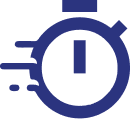Addressing the challenges
Rare conditions are not really rare; there are more than 10,000 recognized rare conditions. Yet in each individual condition, the affected populations are usually small. For example, only about 1 in 3,500 to 5,000 boys are born with Duchenne around the world each year. Other conditions may have even smaller patient populations. This creates unique challenges for researchers who are trying to develop safe and effective therapies.
Duchenne and the LGMDs each affect small populations around the world. This makes it hard to create plans for research and clinical studies that address how these conditions affect different people.
- Small populations mean fewer people are available to participate in clinical studies, making it hard to collect enough data to determine if an investigational product works
- Because each person experiences their condition differently, studies must address individual needs, as well as answer general questions about the condition
- Ensuring that the right mix of participants is included in a study means selecting a smaller group from an already small population
- People may live far from centers where research is taking place, making it harder for them to participate and receive consistent follow‑up
- Enrolling enough people and gathering enough data to understand the benefits and risks of a treatment in a rare disease can take longer than it would in a condition that impacts a much larger group of people
The FDA has made exceptions to some of its rules that enable studies of rare conditions to move forward.
See how Sarepta is developing new products to treat rare conditions.
FDA’s expedited programs for serious conditions
An investigational product may be reviewed and, if appropriate, approved more quickly if it is for a serious condition where treatment options are limited or don’t exist. The FDA has multiple expedited programs to support the development and review of potential products that address serious conditions with unmet medical need:

Fast-track: A process designed to help shorten the time it takes to develop and review drugs that treat serious conditions and address an unmet medical need. It allows early and frequent communication between the drug company and the FDA to help resolve questions and issues quickly.

Breakthrough therapy: The FDA can speed up the development and review of a drug if evidence from early clinical trials shows that it may be a substantial improvement compared with other available treatments. The evidence can include the effect of the drug on serious symptoms, or if it provides life-saving benefits. Breakthrough designation includes the benefits of Fast-track and also provides intensive guidance on efficient drug development and involvement of FDA senior management.

Priority review: A priority review means that the FDA will aim to take action on a new drug application (NDA) or biologics license application (BLA) within 6 months (compared with 10 months under standard review). This designation may be granted for drugs that treat a serious condition and, if approved, would provide significant improvement in safety or effectiveness.

Accelerated approval: An FDA approval pathway that allows early approval for drugs that treat serious or life-threatening conditions with unmet medical need. Drugs granted accelerated approval must meet the same FDA standards for safety and effectiveness as those granted traditional approval; however, accelerated approval may be given based on the drug’s effect on a surrogate endpoint—a measure that is reasonably likely to predict clinical benefit. Confirmatory trials are required to verify that the drug has clinical benefit to patients.

Natural history studies: another way for you to contribute to science
The natural history of a condition is defined as the course it takes in the absence of any treatment, from the start of symptoms through the resolution of the condition or the lifetime of the patient. However, because so few people experience these conditions, there is typically very limited information available about how they affect people over time. You can make an important contribution by being part of a natural history study.
Unlike a clinical trial, natural history studies are observational and non-interventional by design, which means that people in such studies are not given a new or investigational product. Natural history studies assess how a condition progresses over time if untreated or if the patient is receiving the current standard of care, and what factors might cause the condition to progress faster or more slowly. This kind of study can be used for:
- gaining more accurate estimates of how common a condition is
- identifying and understanding different subtypes
- identifying and evaluating potential biomarkers
- evaluating potential assessments of clinical outcomes
- informing the design of clinical studies, including how long they should run, who should be included or excluded, and what endpoints should be measured
In designing clinical studies of treatments for rare conditions, natural history studies may be especially valuable if a placebo control group is not an option. Sponsors and regulators such as the FDA may discuss the option of using a natural history group instead of a placebo control group when the size of the population being studied is small.
Natural history studies provide crucial insights into the patterns, symptoms, and potential complications of rare conditions. This information is vital for developing treatments, improving patient care, and guiding research efforts to discover new possibilities.
Patient registries: a different way to collect data

Unlike a natural history study, a patient registry can be set up to collect any kind of information, from the safety and efficacy of products after they are approved to cost‑effectiveness of treatments and patient quality of life. Some of the most common uses of registries are:
- collection of information about a condition
- advancement of research goals
- clinical trial recruitment
- observation of population behavior patterns
- monitoring of outcomes
- study of best practices for patient care
A comparison of both the total costs and health outcomes of one or more treatments.
